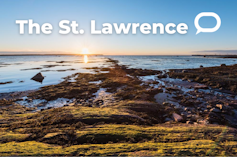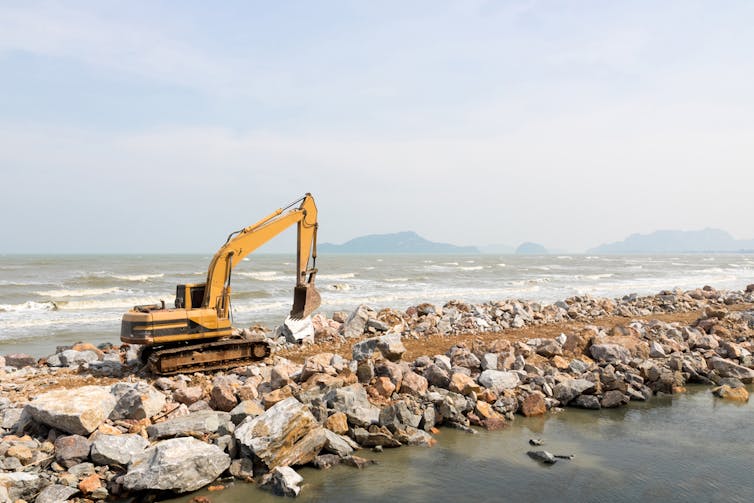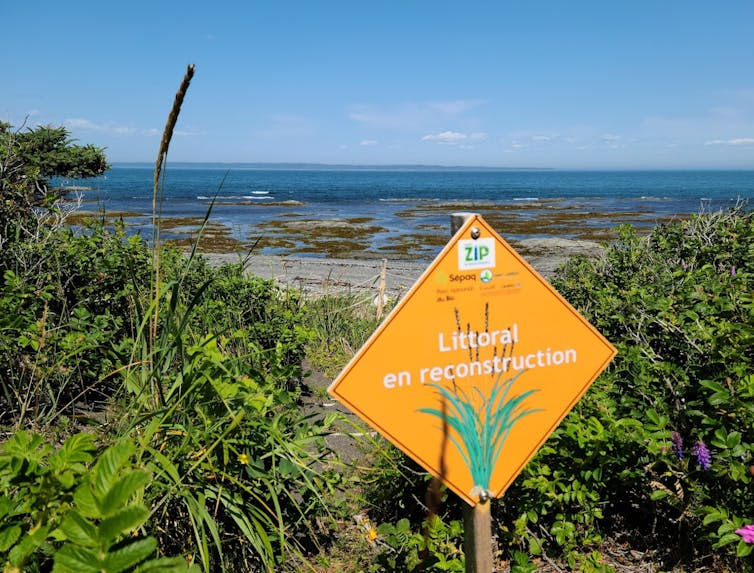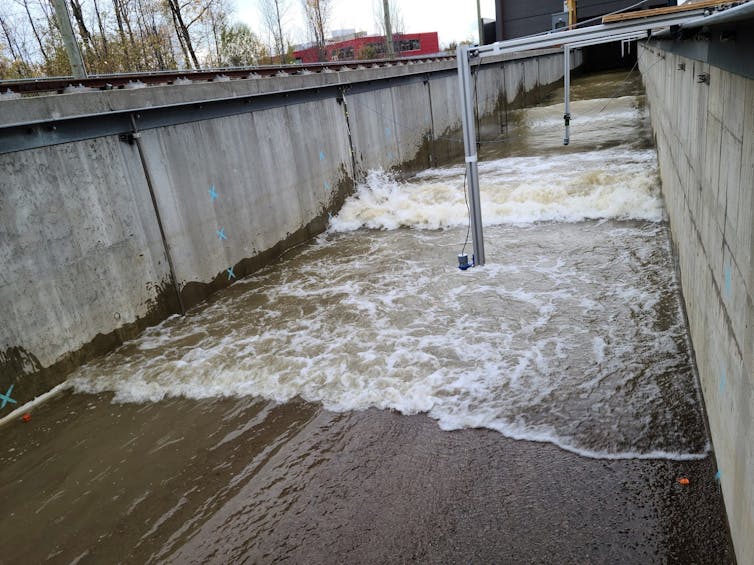
The St. Lawrence riverbanks are eroding. This has an impact on infrastructure, economy and inhabitants’ well-being. It exposes communities to flooding and can destroy local ecosystems.
Under the threat of a climate catastrophe, an in-depth reflection is essential to adapt to the changing climate in the St. Lawrence.
In Prince Edward Island, the average erosion rate is about 0.3 metres per year. In New Brunswick, it is about 0.5 metres per year. In Quebec, it is closer to two metres per year!
This rate of erosion is expected to increase as climate change raises sea levels, bringing water closer to local communities. More frequent and stronger storms will generate larger waves and the reduction in sea ice coverage will give winter storms access to the coast, where the land comes into contact with the sea.

This article is part of our series, The St. Lawrence River: In depth. Don’t miss new articles on this mythical river of remarkable beauty. Our experts look at its fauna, flora and history, and the issues it faces. This series is brought to you by La Conversation.
The latest report from the United Nations’ Intergovernmental Panel on Climate Change (IPCC) calls for transformative adaptation, to completely rethink the way we adapt to climate change to include more sustainable solutions.
As professors of coastal engineering, we work to develop resilient solutions to adapt to climate change in coastal and estuarial environments. We work with communities, businesses and non-profit organizations to better understand how natural systems can be used to protect coasts from erosion and flooding.
Traditional approaches are no longer appropriate
Almost all — 97 per cent — of Quebec’s coastal infrastructure is composed of “hard” structures. You can see these dikes and barriers along the St. Lawrence River, designed to maintain or extend the coastline.
This approach is advocated worldwide, with most design manuals, research and case studies focusing on hard infrastructure; it has been used for centuries. These types of infrastructure-based adaptation methods are well established and have a proven track record in solving short-term problems without occupying significant shoreline.

The problem with hard infrastructure is that it does not adapt to the changing climate. As such, it often requires maintenance and restoration, and can hinder the natural evolution of the coastline. This is known as coastal squeeze.
Coastal squeeze is particularly problematic where coastlines have been designed to treat acute symptoms (such as local flooding) rather than address the underlying problem. These limits, if not properly managed, tend to shift or worsen the problem.
Examples can be seen in Kamouraska Bay, in the St. Lawrence River, where land recovery with dikes for agricultural use has resulted in the loss of three-quarters of the marsh ecosystem over the past century. In addition, these dikes were breached during recent floods, trapping salt water on farmland.
Working with nature in a changing climate
The implications of climate change are becoming increasingly obvious. Its effects are being felt throughout the St. Lawrence: beaches are eroding and more communities are at risk of flooding. Communities must find ways to adapt.
One of the key strategies proposed to adapt to the impacts of climate change is that of “nature-based solutions”. These are coastal protection systems designed to include or mimic natural ecosystems to protect and stabilize the coastline.
One example of a nature-based solutions application is that of Forillon National Park, where hard infrastructure protecting a road had disrupted natural coastal dynamics and led to the loss of the local beach. Researchers worked with the park department to move the road away from the coast and restore the beach vegetation to help the beach to recover naturally.

Another example is the realignment of the Belcher Street dike in Nova Scotia. For this project, researchers worked with farmers and local governments to relocate a dike so that flood water could be diverted from the local community to areas that once held the river overflow water. As a result, it also permitted water to return to the floodplain, restoring the local wetland ecosystem.
A multidisciplinary and participatory approach
Nature-based solutions are not simply about planting plants and then walking away. It is a comprehensive system based on a multidisciplinary and participatory approach that entails working with ecosystems, communities and local economies to find solutions.
This can range from protecting local wetlands to greening hard infrastructure to boost ecological value, for example to provide habitats for oysters and fish species.
Our research team is busy testing solutions co-developed by multidisciplinary groups in our large wave channel. This channel, the largest in North America, allows us to test and optimize solutions and technologies in a controlled environment before they are implemented in the real world.

For example, we are currently studying how coastal marsh restoration can protect against coastal erosion and reduce wave energy. Thanks to knowledge gained from the experiments, we can develop guidelines to help engineers integrate marsh restoration into future projects.
Adapting solutions for the St. Lawrence
In general, the biggest challenge to implementing nature-based solutions is the lack of understanding and guidance regarding their performance in cold regions like Canada. Several guidelines have recently been published at the international level but they tend to be fairly high-level without specific details on how to implement them.
Therefore, as researchers, we must test solutions relevant to the St. Lawrence in the laboratory or in simulation models to predict how they will actually react.
It is also important to set up comprehensive and multidisciplinary monitoring programs after the implementation of these solutions to develop a deeper understanding of how they work.
While provincial and federal governments have begun to put in place long-term programs incorporating sustainable solutions, it is important to realize that the shores of the St. Lawrence are already eroding and will continue to erode.
We must act quickly to solve tomorrow’s problem.
Jacob Stolle, Professeur adjoint, hydrodynamique côtière et fluviale, Institut national de la recherche scientifique (INRS) and Damien Pham-Van-Bang, Associate professor, Institut national de la recherche scientifique (INRS)
This article is republished from The Conversation under a Creative Commons license. Read the original article.











